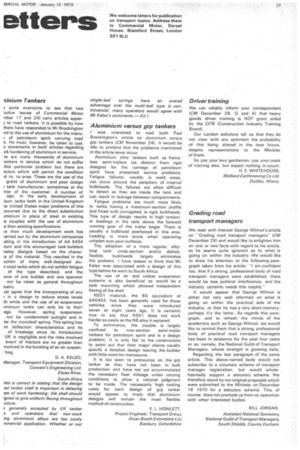Aluminium versus grp tankers
Page 29

If you've noticed an error in this article please click here to report it so we can fix it.
I was interested to read both Paul Brockington's article on aluminium versus grp tankers (CM November 24). It would be idle to pretend that the problems mentioned in the article never occur.
Aluminium alloy tankers built as frameless semi-trailers (as distinct from rigid designs) for the carriage of petroleum spirit have presented service problems. Fatigue failures, usually in weld areas, can occur around the periphery of internal' bulkheads. The failures are often difficult to detect as they are inside the tank and can result in leakage between compartments.
Fatigue problems are much more 'likely in tanks having a maximum-section profile and fitted with corrugated, ie rigid, bulkheads. This type of design results in high torsional loadings in the tank above the forward running gear of the trailer bogie. There is usually a bulkhead positioned in this area. Loading is more acute when operating unladen over poor surfaces.
The adoption of a more regular, elliptical tank cross-section and/or dished, flexible, bulkheads largely eliminates the problem. I have reason to think that Mr Kelso was associated with a design of this type before he went to South Africa.
The use of air and rubber suspension systems is also beneficial as would be a tank mounting which allowed independent flexing of the shell.
NS51 material, the BS equivalent of AA5454, has been generally used for these vehicles since they were introduced seven or eight years ago. It is certainly true to say that NS51 does not work harder so easily as the N8 alloy it replaced.
To summarize, the trouble is largely confined to max-section semi-trailer tankers for petroleum spirit and is a design problem. It is only fair to the constructors to point out that their major clients usually specify a detailed design leaving the builder with little room for manoeuvre.
It is too soon to pronounce on the grp tanker as they have not been in bulk production and have not yet accummulated the necessary fleet mileage under varying conditions to allow a rational judgment to be made. The necessarily high tooling costs for each design of grp tanker would appear to imply that aluminium designs will remain the most flexible method of construction.
E. L. HOWLETT, Project Engineer, Transport Group, Akan Booth Extrusions Ltd, Banbury, Oxfordshire








































































































